#monastery of christ in the desert
Explore tagged Tumblr posts
Text

"Prayer does not primarily have to do with any kind of mental exchange (although that has its place) but with a proximity of hearts; in other words, with love."
~Image and text from the Monastery of Christ in the Desert
14 notes
·
View notes
Text
The European mind cannot comprehend the sanctity of a 24 hour American roadside diner three hundred miles out on a desert highway. They are holy sites. Monasteries of Americana shining bright to the tired and weary in the darkest nights. Christ died for our sins on the cross, but the graveyard shift line cook at Denny's gave us the very meaning of life itself.
567 notes
·
View notes
Text
Have a little snippet of John and Francis in Geneva!
~~~
“Oh, you all think me ignorant,” Kinloch grumbles.
They stumble their way across the town square, deserted except for a lone officer guarding the door to the courthouse.
“Don’t be so dramatic,” John chides, knocking Kinloch’s arm with the back of his, a little too drunk to care about discretion. “But you must concede that our side has some merit.”
“Your side!”
“Well— yes.” He doesn’t want to fight, least of all about politics, but he won’t concede this point. “I have read extensively on it, and the rightness - the goodness - of a meritocratic—“
“Oh, you and your reading, Jack - for god’s sake!” Kinloch exclaims. “Not all wisdom is in books.”
He frowns. “But Rousseau—”
Kinloch covers his ears with his hands, humming an obnoxious tune and drawing the bored gaze of the guard. John ducks his head and pushes his hands into his pockets.
“You’re impossible,” he mutters, once Kinloch has dropped his hands again.
“I am tired. And bored. Christ, do you only talk of virtue and poetry, and drink only water, and eat dry bread?”
“This is not Eton, Frank - it’s Geneva.”
Kinloch turns around, walking backwards and spreading his arms wide as though to encompass the city. “And when did Geneva become a monastery?” he cries out, his voice ringing in the empty square.
31 notes
·
View notes
Text
August 1, 2024: The stench of sin

St. Gerasimos of the Jordan with his lion Jordanes.
The stench of sin. All humans sin and all humans have the stench of sin. Those who deal with dark entities have reported for hundreds of years the manifestation of horrid smells accompanying the enemy and his allies. It seems that the good are accompanied by good smells and the evil are accompanied by foul ones in the plane of the soul.
We know that sin, straying from God’s light, is equivalent to death. We were not created to experience physical death, we were created with free will and not blessed with the power to heal our bodies beyond natural laws. Free will and the enemy’s temptations of the flesh culminated in the first sin, and started Adam and Eve’s bodily clock of decay which all who are born of both male and female flesh inherit.
God loves and cares for all His creation. We could not wander the Garden with decaying bodies and naïve souls. We were sent to Earth to live as both body and soul, and are given the chance to die daily to the flesh, repent and rebuke sin and the passions, and live for God by serving his children in compassionate love and forgiveness.
Orthodox monastics are monks and nuns who seek refuge from the sickness of the world and the human condition to live for God entirely. It is written that
He who seeks to save his life will lose it, but he who loses his life for My sake will find it.
We will all lose our lives at the end of our time on Earth. The treasures you toil to build up here on Earth will become lost to you and to future generations in time. What about the soul? To comfort the soul with eternal life after death and reunion with the source of all universal power, monastics leave their entire Earthly lives to know, love, and serve God in this life. As a result of this, many monastics become extremely good and pure, and some become holy, of which God is the Most Holy. They become saints for having a heart so completely dedicated to God with no space at all for the passions.
These individuals, such as St. Gerasimos of the Jordan, became so free from Earthly sin that they began to lose the stench of their sins. A stench that we humans cannot sense, because with our bodies grounding our souls to the Earth, we cannot perceive things in our spirit. A stench, however, that animals can pick up on. With every sin we gain a blemish on our souls that takes it further away from its original state… a childlike state of innocence, blamelessness, love, and friendship.
Unless you change and become like little children, you will never enter the Kingdom of Heaven.
St. Gerasimos encountered a fierce lion in the desert and the lion, sensing he was not like other humans because of the scentlessness and cleanliness of his soul, did not attack Father Gerasimos and instead became obedient to him. Father Gerasimos and his monastery’s brothers named the lion Jordanes and they lived in peace, until Father Gerasimos fell asleep in the Lord and Jordanes followed him to his grave the minute he realized Gerasimos’ death.
As Orthodox Christians, we strive to die daily to the flesh and lead our lives both in Christlikeness and in the spirit of His perfect love. We serve the King of the Universe, and all human hearts already know His law, though they may be lost. We are called to love all people as they are all beloved by God and made in His own image, though God is not an old man with a beard in a flowy white robe. He is woven into the very fabric of the universe, He is the nighttime wind ripping through the leaves of an oak tree, He is the warm heart of a stranger caring for you for seemingly no reason.
If you know a very good and loving person who seems to attract and be loved by animals, you might very well know why. God bless and keep you and your loved ones❤️🔥 Glory be to Jesus Christ.



#orthodox christianity#christianity#lifestyle#jesus#jesus christ#orthodox church#jesus is king#taylor swift#ice spice#tiktok#love#bible#bible verse#bible scripture#bible study#bible quote#holy bible#christian bible#new testament#god is good#god is love#orthodox saints#desert fathers#lion#animals#cute animals#cute cats#cute#olympics#usa
9 notes
·
View notes
Text

5th Sunday of Great Lent: St Mary of Egypt
Commemorated on April 21
In you, O Mother, was preserved with exactness what was according to the image; for you took up the Cross and followed Christ. By so doing, you taught us to disregard the flesh, for it passes away; but to care for the soul, since it is immortal. Therefore, O Venerable Mary, your spirit rejoices with the Angels.
Saint Zosimas (April 4) was a monk at a certain Palestinian monastery on the outskirts of Caesarea. Having dwelt at the monastery since his childhood, he lived there in asceticism until he reached the age of fifty-three. Then he was disturbed by the thought that he had attained perfection, and needed no one to instruct him. “Is there a monk anywhere who can show me some form of asceticism that I have not attained? Is there anyone who has surpassed me in spiritual sobriety and deeds?”
Suddenly, an angel of the Lord appeared to him and said, “Zosimas, you have struggled valiantly, as far as this is in the power of man. However, there is no one who is righteous (Rom 3:10). So that you may know how many other ways lead to salvation, leave your native land, like Abraham from the house of his father (Gen 12:1), and go to the monastery by the Jordan.”
Abba Zosimas immediately left the monastery, and following the angel, he went to the Jordan monastery and settled in it.
Here he met Elders who were adept in contemplation, and also in their struggles. Never did anyone utter an idle word. Instead, they sang constantly, and prayed all night long. Abba Zosimas began to imitate the spiritual activity of the holy monks.
Thus much time passed, and the holy Forty Day Fast approached. There was a certain custom at the monastery, which was why God had led Saint Zosimas there. On the First Sunday of Great Lent the igumen served the Divine Liturgy, everyone received the All-Pure Body and Blood of Christ. Afterwards, they went to the trapeza for a small repast, and then assembled once more in church.
The monks prayed and made prostrations, asking forgiveness one of another. Then they made a prostration before the igumen and asked his blessing for the struggle that lay before them. During the Psalm “The Lord is my Light and my Savior, whom shall I fear? The Lord is defender of my life, of whom shall I be afraid?” (Ps 26/27:1), they opened the monastery gate and went off into the wilderness.
Each took with him as much food as he needed, and went into the desert. When their food ran out, they ate roots and desert plants. The monks crossed the Jordan and scattered in various directions, so that no one might see how another fasted or how they spent their time.
The monks returned to the monastery on Palm Sunday, each having his own conscience as a witness of his ascetic struggles. It was a rule of the monastery that no one asked how anyone else had toiled in the desert.
Abba Zosimas, according to the custom of the monastery, went deep into the desert hoping to find someone living there who could benefit him.
He walked into the wilderness for twenty days and then, when he sang the Psalms of the Sixth Hour and made the usual prayers. Suddenly, to the right of the hill where he stood, he saw a human form. He was afraid, thinking that it might be a demonic apparition. Then he guarded himself with the Sign of the Cross, which removed his fear. He turned to the right and saw a form walking southward. The body was black from the blazing sunlight, and the faded short hair was white like a sheep’s fleece. Abba Zosimas rejoiced, since he had not seen any living thing for many days.
The desert-dweller saw Zosimas approaching, and attempted to flee from him. Abba Zosimas, forgetting his age and fatigue, quickened his pace. When he was close enough to be heard, he called out, “Why do you flee from me, a sinful old man? Wait for me, for the love of God.”
The stranger said to him, “Forgive me, Abba Zosimas, but I cannot turn and show my face to you. I am a woman, and as you see, I am naked. If you would grant the request of a sinful woman, throw me your cloak so I might cover my body, and then I can ask for your blessing.”
Then Abba Zosimas was terrified, realizing that she could not have called him by name unless she possessed spiritual insight.
Covered by the cloak, the ascetic turned to Zosimas: “Why do you want to speak with me, a sinful woman? What did you wish to learn from me, you who have not shrunk from such great labors?”
Abba Zosimas fell to the ground and asked for her blessing. She also bowed down before him, and for a long time they remained on the ground each asking the other to bless. Finally, the woman ascetic said: “Abba Zosimas, you must bless and pray, since you are honored with the grace of the priesthood. For many years you have stood before the holy altar, offering the Holy Gifts to the Lord.”
These words frightened Saint Zosimas even more. With tears he said to her, “O Mother! It is clear that you live with God and are dead to this world. You have called me by name and recognized me as a priest, though you have never seen me before. The grace granted you is apparent, therefore bless me, for the Lord’s sake.”
Yielding finally to his entreaties, she said, “Blessed is God, Who cares for the salvation of men.” Abba Zosimas replied, “Amen.” Then they rose to their feet. The woman ascetic again said to the Elder, “Why have you come, Father, to me who am a sinner, bereft of every virtue? Apparently, the grace of the Holy Spirit has brought you to do me a service. But tell me first, Abba, how do the Christians live, how is the Church guided?”
Abba Zosimas answered her, “By your holy prayers God has granted the Church and us all a lasting peace. But fulfill my unworthy request, Mother, and pray for the whole world and for me a sinner, that my wanderings in the desert may not be useless.”
The holy ascetic replied, “You, Abba Zosimas, as a priest, ought to pray for me and for all, for you are called to do this. However, since we must be obedient, I will do as you ask.
The saint turned toward the East, and raising her eyes to heaven and stretching out her hands, she began to pray in a whisper. She prayed so softly that Abba Zosimas could not hear her words. After a long time, the Elder looked up and saw her standing in the air more than a foot above the ground. Seeing this, Zosimas threw himself down on the ground, weeping and repeating, “Lord, have mercy!”
Then he was tempted by a thought. He wondered if she might not be a spirit, and if her prayer could be insincere. At that moment she turned around, lifted him from the ground and said, “Why do your thoughts confuse you, Abba Zosimas? I am not an apparition. I am a sinful and unworthy woman, though I am guarded by holy Baptism.”
Then she made the Sign of the Cross and said, “May God protect us from the Evil One and his schemes, for fierce is his struggle against us.” Seeing and hearing this, the Elder fell at her feet with tears saying, “I beseech you by Christ our God, do not conceal from me who you are and how you came into this desert. Tell me everything, so that the wondrous works of God may be revealed.”
She replied, “It distresses me, Father, to speak to you about my shameless life. When you hear my story, you might flee from me, as if from a poisonous snake. But I shall tell you everything, Father, concealing nothing. However, I exhort you, cease not to pray for me a sinner, that I may find mercy on the Day of Judgment.
“I was born in Egypt and when I was twelve years old, I left my parents and went to Alexandria. There I lost my chastity and gave myself to unrestrained and insatiable sensuality. For more than seventeen years I lived like that and I did it all for free. Do not think that I refused the money because I was rich. I lived in poverty and worked at spinning flax. To me, life consisted in the satisfaction of my fleshly lust.
“One summer I saw a crowd of people from Libya and Egypt heading toward the sea. They were on their way to Jerusalem for the Feast of the Exaltation of the Holy Cross. I also wanted to sail with them. Since I had no food or money, I offered my body in payment for my passage. And so I embarked on the ship.
“Now, Father, believe me, I am very amazed, that the sea tolerated my wantonness and fornication, that the earth did not open up its mouth and take me down alive into hell, because I had ensnared so many souls. I think that God was seeking my repentance. He did not desire the death of a sinner, but awaited my conversion.
“So I arrived in Jerusalem and spent all the days before the Feast living the same sort of life, and maybe even worse.
“When the holy Feast of the Exaltation of the Venerable Cross of the Lord arrived, I went about as before, looking for young men. At daybreak I saw that everyone was heading to the church, so I went along with the rest. When the hour of the Holy Elevation drew nigh, I was trying to enter into the church with all the people. With great effort I came almost to the doors, and attempted to squeeze inside. Although I stepped up to the threshold, it was as though some force held me back, preventing me from entering. I was brushed aside by the crowd, and found myself standing alone on the porch. I thought that perhaps this happened because of my womanly weakness. I worked my way into the crowd, and again I attempted to elbow people aside. However hard I tried, I could not enter. Just as my feet touched the church threshold, I was stopped. Others entered the church without difficulty, while I alone was not allowed in. This happened three or four times. Finally my strength was exhausted. I went off and stood in a corner of the church portico.
“Then I realized that it was my sins that prevented me from seeing the Life-Creating Wood. The grace of the Lord then touched my heart. I wept and lamented, and I began to beat my breast. Sighing from the depths of my heart, I saw above me an icon of the Most Holy Theotokos. Turning to Her, I prayed: “O Lady Virgin, who gave birth in the flesh to God the Word! I know that I am unworthy to look upon your icon. I rightly inspire hatred and disgust before your purity, but I know also that God became Man in order to call sinners to repentance. Help me, O All-Pure One. Let me enter the church. Allow me to behold the Wood upon which the Lord was crucified in the flesh, shedding His Blood for the redemption of sinners, and also for me. Be my witness before Your Son that I will never defile my body again with the impurity of fornication. As soon as I have seen the Cross of your Son, I will renounce the world, and go wherever you lead me.”
“After I had spoken, I felt confidence in the compassion of the Mother of God, and left the spot where I had been praying. I joined those entering the church, and no one pushed me back or prevented me from entering. I went on in fear and trembling, and entered the holy place.
“Thus I also saw the Mysteries of God, and how God accepts the penitant. I fell to the holy ground and kissed it. Then I hastened again to stand before the icon of the Mother of God, where I had given my vow. Bending my knees before the Virgin Theotokos, I prayed:
“‘O Lady, you have not rejected my prayer as unworthy. Glory be to God, Who accepts the repentance of sinners. It is time for me to fulfill my vow, which you witnessed. Therefore, O Lady, guide me on the path of repentance.’”
“Then I heard a voice from on high: ‘If you cross the Jordan, you will find glorious rest.’
“I immediately believed that this voice was meant for me, and I cried out to the Mother of God: ‘O Lady, do not forsake me!’
“Then I left the church portico and started on my journey. A certain man gave me three coins as I was leaving the church. With them I bought three loaves of bread, and asked the bread merchant the way to the Jordan.
“It was nine o’clock when I saw the Cross. At sunset I reached the church of Saint John the Baptist on the banks of the Jordan. After praying in the church, I went down to the Jordan and washed my face and hands in its water. Then in this same temple of Saint John the Forerunner I received the Life-Creating Mysteries of Christ. Then I ate half of one of my loaves of bread, drank water from the holy Jordan, and slept there that night on the ground. In the morning I found a small boat and crossed the river to the opposite shore. Again I prayed that the Mother of God would lead me where She wished. Then I found myself in this desert.”
Abba Zosimas asked her, “How many years have passed since you began to live in the desert?”
“‘I think,” she replied, “it is forty-seven years since I came from the Holy City.”
Abba Zosimas again asked, “What food do you find here, Mother?”
And she said, “I had with me two and a half loaves of bread when I crossed the Jordan. Soon they dried out and hardened Eating a little at a time, I finished them after a few years.”
Again Abba Zosimas asked, “Is it possible you have survived for so many years without sickness, and without suffering in any way from such a complete change?”
“Believe me, Abba Zosimas,” the woman said, “I spent seventeen years in this wilderness (after she had spent seventeen years in immorality), fighting wild beasts: mad desires and passions. When I began to eat bread, I thought of the meat and fish which I had in abundance in Egypt. I also missed the wine that I loved so much when I was in the world, while here I did not even have water. I suffered from thirst and hunger. I also had a mad desire for lewd songs. I seemed to hear them, disturbing my heart and my hearing. Weeping and striking myself on the breast, I remembered the vow I had made. At last I beheld a radiant Light shining on me from everywhere. After a violent tempest, a lasting calm ensued.
“Abba, how shall I tell you of the thoughts that urged me on to fornication? A fire seemed to burn within me, awakening in me the desire for embraces. Then I would throw myself to the ground and water it with my tears. I seemed to see the Most Holy Virgin before me, and She seemed to threaten me for not keeping my vow. I lay face downward day and night upon the ground, and would not get up until that blessed Light encircled me, dispelling the evil thoughts that troubled me.
“Thus I lived in this wilderness for the first seventeen years. Darkness after darkness, misery after misery stood about me, a sinner. But from that time until now the Mother of God helps me in everything.”
Abba Zosimas again inquired, “How is it that you require neither food, nor clothing?”
She answered, “After finishing my bread, I lived on herbs and the things one finds in the desert. The clothes I had when I crossed over the Jordan became torn and fell apart. I suffered both from the summer heat, when the blazing heat fell upon me, and from the winter cold, when I shivered from the frost. Many times I fell down upon the earth, as though dead. I struggled with various afflictions and temptations. But from that time until the present day, the power of God has guarded my sinful soul and humble body. I was fed and clothed by the all-powerful word of God, since man does not live by bread alone, but by every word proceeding from the mouth of God (Dt 8:3, Mt.4:4, Luke 4:4), and those who have put off the old man (Col 3:9) have no refuge, hiding themselves in the clefts of the rocks (Job 24:8, Heb 11:38). When I remember from what evil and from what sins the Lord delivered me, I have imperishible food for salvation.”
When Abba Zosimas heard that the holy ascetic quoted the Holy Scripture from memory, from the Books of Moses and Job and from the Psalms of David, he then asked the woman, “Mother, have you read the Psalms and other books?”
She smiled at hearing this question, and answered, “Believe me, I have seen no human face but yours from the time that I crossed over the Jordan. I never learned from books. I have never heard anyone read or sing from them. Perhaps the Word of God, which is alive and acting, teaches man knowledge by itself (Col 3:16, 1 Thess 2:13). This is the end of my story. As I asked when I began, I beg you for the sake of the Incarnate Word of God, holy Abba, pray for me, a sinner.
“Furthermore, I beg you, for the sake of Jesus Christ our Lord and Savior, tell no one what you have heard from me, until God takes me from this earth. Next year, during Great Lent, do not cross the Jordan, as is the custom of your monastery.”
Again Abba Zosimas was amazed, that the practice of his monastery was known to the holy woman ascetic, although he had not said anything to her about this.
“Remain at the monastery,” the woman continued. “Even if you try to leave the monastery, you will not be able to do so. On Great and Holy Thursday, the day of the Lord’s Last Supper, place the Life-Creating Body and Blood of Christ our God in a holy vessel, and bring it to me. Await me on this side of the Jordan, at the edge of the desert, so that I may receive the Holy Mysteries. And say to Abba John, the igumen of your community, ‘Look to yourself and your brothers’ (1 Tim 4:16), for there is much that needs correction. Do not say this to him now, but when the Lord shall indicate.”
Asking for his prayers, the woman turned and vanished into the depths of the desert.
For a whole year Elder Zosimas remained silent, not daring to reveal to anyone what he had seen, and he prayed that the Lord would grant him to see the holy ascetic once more.
When the first week of Great Lent came again, Saint Zosimas was obliged to remain at the monastery because of sickness. Then he remembered the woman’s prophetic words that he would not be able to leave the monastery. After several days went by, Saint Zosimas was healed of his infirmity, but he remained at the monastery until Holy Week.
On Holy Thursday, Abba Zosimas did what he had been ordered to do. He placed some of the Body and Blood of Christ into a chalice, and some food in a small basket. Then he left the monastery and went to the Jordan and waited for the ascetic. The saint seemed tardy, and Abba Zosimas prayed that God would permit him to see the holy woman.
Finally, he saw her standing on the far side of the river. Rejoicing, Saint Zosimas got up and glorified God. Then he wondered how she could cross the Jordan without a boat. She made the Sign of the Cross over the water, then she walked on the water and crossed the Jordan. Abba Zosimas saw her in the moonlight, walking toward him. When the Elder wanted to make prostration before her, she forbade him, crying out, “What are you doing, Abba? You are a priest and you carry the Holy Mysteries of God.”
Reaching the shore, she said to Abba Zosimas, “Bless me, Father.” He answered her with trembling, astonished at what he had seen. “Truly God did not lie when he promised that those who purify themselves will be like Him. Glory to You, O Christ our God, for showing me through your holy servant, how far I am from perfection.”
The woman asked him to recite both the Creed and the “Our Father.” When the prayers were finished, she partook of the Holy Mysteries of Christ. Then she raised her hands to the heavens and said, “Lord, now let Your servant depart in peace, for my eyes have seen Your salvation.”
The saint turned to the Elder and said, “Please, Abba, fulfill another request. Go now to your monastery, and in a year’s time come to the place where we first time spoke.”
He said, “If only it were possible for me to follow you and always see your holy face!”
She replied, “For the Lord’s sake, pray for me and remember my wrechedness.”
Again she made the Sign of the Cross over the Jordan, and walked over the water as before, and disappeared into the desert. Zosimas returned to the monastery with joy and terror, reproaching himself because he had not asked the saint’s name. He hoped to do so the following year.
A year passed, and Abba Zosimas went into the desert. He reached the place where he first saw the holy woman ascetic. She lay dead, with arms folded on her bosom, and her face was turned to the east. Abba Zosimas washed her feet with his tears and kissed them, not daring to touch anything else. For a long while he wept over her and sang the customary Psalms, and said the funeral prayers. He began to wonder whether the saint would want him to bury her or not. Hardly had he thought this, when he saw something written on the ground near her head: “Abba Zosimas, bury on this spot the body of humble Mary. Return to dust what is dust. Pray to the Lord for me. I reposed on the first day of April, on the very night of the saving Passion of Christ, after partaking of the Mystical Supper.”
Reading this note, Abba Zosimas was glad to learn her name. He then realized that Saint Mary, after receiving the Holy Mysteries from his hand, was transported instantaneously to the place where she died, though it had taken him twenty days to travel that distance.
Glorifying God, Abba Zosimas said to himself, “It is time to do what she asks. But how can I dig a grave, with nothing in my hands?” Then he saw a small piece of wood left by some traveler. He picked it up and began to dig. The ground was hard and dry, and he could not dig it. Looking up, Abba Zosimas saw an enormous lion standing by the saint’s body and licking her feet. Fear gripped the Elder, but he guarded himself with the Sign of the Cross, believing that he would remain unharmed through the prayers of the holy woman ascetic. Then the lion came close to the Elder, showing its friendliness with every movement. Abba Zosimas commanded the lion to dig the grave, in order to bury Saint Mary’s body. At his words, the lion dug a hole deep enough to bury the body. Then each went his own way. The lion went into the desert, and Abba Zosimas returned to the monastery, blessing and praising Christ our God.
Arriving at the monastery, Abba Zosimas related to the monks and the igumen, what he had seen and heard from Saint Mary. All were astonished, hearing about the miracles of God. They always remembered Saint Mary with faith and love on the day of her repose.
Abba John, the igumen of the monastery, heeded the words of Saint Mary, and with the help of God corrected the things that were wrong at the monastery. Abba Zosimas lived a God-pleasing life at the monastery, reaching nearly a hundred years of age. There he finished his temporal life, and passed into life eternal.
The monks passed on the life of Saint Mary of Egypt by word of mouth without writing it down.
“I however,” says Saint Sophronius of Jerusalem (March 11), “wrote down the Life of Saint Mary of Egypt as I heard it from the holy Fathers. I have recorded everything, putting the truth above all else.”
“May God, Who works great miracles and bestows gifts on all who turn to Him in faith, reward those who hear or read this account, and those who copy it. May he grant them a blessed portion together with Saint Mary of Egypt and with all the saints who have pleased God by their pious thoughts and works. Let us give glory to God, the Eternal King, that we may find mercy on the Day of Judgment through our Lord Jesus Christ, to Whom is due all glory, honor, majesty and worship together with the Unoriginate Father, and the Most Holy and Life-Creating Spirit, now and ever and unto ages of ages. Amen.”
[Text from OCA]
Having been a sinful woman, you became a Bride of Christ through repentance. Having attained the angelic life, you defeated demons by the weapon of the Cross; therefore, O most glorious Mary you are a Bride of the Kingdom.
11 notes
·
View notes
Text

+++🙏🏻God Bless🕊️+++
St. Methodius of Peshnosh, Abbot
MEMORIAL DAY JUNE 17
We kindle love for God from our youth, having hated all worldly goods, you loved Christ Alone and therefore settled in the desert, created a monastery in it and, gathering many monks, received from God the gift of miracles, Father Methodius, and you were a zealot and fasterer about Christ, like St. Sergius, with him at Christ Ask God for health and salvation for Orthodox Christians and great mercy for our souls.
💫International Orthodox Art Corporation Andcross May the blessing of the Lord be upon you!
#orthodox christmas#orthodox church#orthodoxia#orthodox icon#russian orthodox#iconofaday#orthodox#greek orthodox#orthodox christian#jesus
6 notes
·
View notes
Text
SAINTS&READING: SUNDAY, NOVEMBER 3, 2024
october 21_october 3
VENERABLE HILLARION THE GREAT OF PALESTINE (371).

Saint Hilarion the Great was born to pagan parents in the year 291 in the Palestinian village of Thabatha near Gaza. As a young man, he was sent to Alexandria for his education. There he became acquainted with Christianity and was baptized. After hearing an account of the angelic life of Saint Anthony the Great (January 17), Hilarion went to meet him, desiring to study with him and learn what is pleasing to God. Hilarion soon returned to his native land to find that his parents had died. After distributing his family’s inheritance to the poor, Saint Hilarion went forth into the desert surrounding the city of Maium.
In the desert the Saint endured violent struggles with impure thoughts, vexations of the mind, and the burning passions of the flesh, but he defeated them through heavy labor, fasting and fervent prayer. The devil sought to frighten him with phantoms and apparitions. While he was praying Saint Hilarion would sometimes hear children crying, women wailing, and the roaring of lions and other wild beasts. He understood that the demons were causing these terrors in order to drive him out of the wilderness. He overcame his fear by resorting to fervent prayer. Once, some thieves fell upon Saint Hilarion, and he persuaded them to forsake their lawless life by the power of his words.
Soon all of Palestine heard about Saint Hilarion and of the miracles he worked. The Lord granted the holy ascetic the power to cast out unclean spirits. With this gift of grace he loosed the bonds of many of those who were afflicted. The sick came for healing, and the Saint cured them without asking for any payment, saying that the grace of God is freely received, and must be freely given (Matthew 10:8).
Such was the grace that he received from God that he could tell by the smell of someone’s body or clothing which passion was afflicting his soul. They came to Saint Hilarion desiring to save their souls under his guidance. With his blessing, monasteries began to spring up throughout Palestine. Going from one monastery to another, he instituted a strict ascetic manner of life.
About seven years before his death (+ 371-372) Saint Hilarion moved back to Cyprus, where the ascetic lived in a solitary place until the Lord summoned him to Himself.
Saint Hilarion is sometimes depicted holding a scroll which reads: "The tools of a monk are steadfastness, humility, and love according to God." In iconography, is depicted as an old man with a brown, rush-like beard divided into three points.
Source: Orthodox Church in America_OC
SAINT CONDEDUS HERMIT OF FONTENELLE (France685)


CONDEDUS (685)
He was an English hermit at the Abbey of St. Valery (Walric) on the Somme (abbaye Saint-Valery-sur-Somme) at present-day Saint-Valery-sur-Somme (northern France) who joined the community of the Abbey of St. Wandrille (abbaye Saint-Wandrille) in Fontenelle, Normandy (north-western France). In later years, St. Condedus lived as a hermit again, this time on an island in the river Seine near present-day Caudebec-en-Caux, not far from Fontenelle Abbey. St. Condedus reposed circa 685.
Source: Orthodox Saints of the Pre-Schism See of Rome

2 Corinthians 11:31-12:9
31 The God and Father of our Lord Jesus Christ, who is blessed forever, knows that I am not lying. 32 In Damascus the governor, under Aretas the king, was guarding the city of the Damascenes with a garrison, desiring to arrest me; 33 but I was let down in a basket through a window in the wall, and escaped from his hands.
1 It is doubtless not profitable for me to boast. I will come to visions and revelations of the Lord: 2 I know a man in Christ who fourteen years ago-whether in the body I do not know, or whether out of the body I do not know, God knows-such a one was caught up to the third heaven. 3 And I know such a man-whether in the body or out of the body I do not know, God knows- 4 how he was caught up into Paradise and heard inexpressible words, which it is not lawful for a man to utter. 5 Of such a one I will boast; yet of myself I will not boast, except in my infirmities. 6 For though I might desire to boast, I will not be a fool; for I will speak the truth. But I refrain, lest anyone should think of me above what he sees me to be or hears from me. 7 And lest I should be exalted above measure by the abundance of the revelations, a thorn in the flesh was given to me, a messenger of Satan to buffet me, lest I be exalted above measure.
Luke 16:19-31
19 There was a certain rich man who was clothed in purple and fine linen and fared sumptuously every day. 20 But there was a certain beggar named Lazarus, full of sores, who was laid at his gate, 21 desiring to be fed with the crumbs which fell from the rich man's table. Moreover the dogs came and licked his sores. 22 So it was that the beggar died, and was carried by the angels to Abraham's bosom. The rich man also died and was buried. 23 And being in torments in Hades, he lifted up his eyes and saw Abraham afar off, and Lazarus in his bosom. 24 Then he cried and said, 'Father Abraham, have mercy on me, and send Lazarus that he may dip the tip of his finger in water and cool my tongue; for I am tormented in this flame.' 25 But Abraham said, 'Son, remember that in your lifetime you received your good things, and likewise Lazarus evil things; but now he is comforted and you are tormented. 26 'And besides all this, between us and you there is a great gulf fixed, so that those who want to pass from here to you cannot, nor can those from there pass to us.' 27 Then he said, 'I beg you therefore, father, that you would send him to my father's house, 28 'for I have five brothers, that he may testify to them, lest they also come to this place of torment.' 29 Abraham said to him, 'They have Moses and the prophets; let them hear them.' 30 And he said, 'No, father Abraham; but if one goes to them from the dead, they will repent.' 31 But he said to him, 'If they do not hear Moses and the prophets, neither will they be persuaded though one rise from the dead.'
#orthodoxy#orthodoxchristianity#easternorthodoxchurch#originofchristianity#spirituality#holyscriptures#gospel#bible#wisdom#faith#saints
2 notes
·
View notes
Text

THE DESCRIPTION OF OUR LADY, STAR OF THE SEA (Stella Maris) The Patroness of the Catholic Missions to the Seafarers Feast Day: September 27
"Caring for seafarers is profoundly a Christian thing to do." -H.E. Vincent Nichols, Archbishop of Westminster, 2016
In the Roman Catholic Church, the Blessed Virgin Mary, Mother of the Divine Savior, Jesus Christ, is Stella Maris – The Star of the Sea. Mary is the daughter of St. Anne and St. Joachim. Both her parents descended from the Royal House of David from the land of Judah. Her father was a shepherd. Her name is Miryam in Hebrew; Mariam in Greek; and Maryam in Judeo-Aramaic – Mar for 'drop' and yam for 'sea.'
In the old Aramaic language, Stella Maris meant pilot, leader or guide, someone who could navigate through the sea or the desert through the position of the stars, and lead people to safety. The stars were and are used as a guide to safety and to new life. The sea covers all the earth and symbolizes all the people of the earth. Mother Mary was therefore identified from the very earliest days of the Church as the 'guiding star' to Her Son for all the people of the earth.
Mary is believed to calm raging storms in the seas, as well as the storms in our lives. She leads us to the right path to Jesus Christ, Her Son, and is a ray of hope. Thus, Mary is regarded as the Stella Maris of fishermen as well as fishers of men, and many coastal churches are named Stella Maris.
The sea has always been the most feared because of its enormous power to sustain or destroy life. People are powerless and insignificant in the midst of the sea’s rage. Yet the sea is a constant source of food and nourishment. The waters of the sea are therefore a metaphor for blessings and perils; beauty and destruction; stillness and turbulence.
In the 12th Century, St. Bernard of Clairvaux, France, a former Benedictine Monk who formed the Cistercian Order, wrote this prayer: "If the winds of temptation arise; if you are driven upon the rocks of tribulation, look to the Star, call on Mary. If you are tossed on the waves of pride, ambition, of envy, of rivalry, look to the Star, call on Mary. Should anger or avarice, or fleshly desire violently assail the frail vessel of your soul, look to the Star, call upon Mary."
In 1221, St. Anthony of Padua, a Portuguese Franciscan Friar wrote a similar prayer: "Our Lady, Star of the Sea, we pray that You shine upon us when we are buffeted by the raging sea. Guide us to harbor, defend our going out with your watchful presence so we may be found fit to go out safely from this prison, and come joyfully to unending joy."
In the 8th Century, St. Paschasius Radbertus of Corbie, Neustria wrote this prayer: "Mary is the Star of the Sea to be followed on the way to Christ, lest we capsize amid the storm-tossed waves of the sea."
St. Paschasius Radbertus was a Carolingian theologian, poet, writer and in 844 AD became the Benedictine Abbot of Corbie, a monastery in Picardy, France founded in 657 by the Queen Regent Bathilde. His letter on the Assumption of Mary was formerly attributed to St. Jerome of Stridon, a Desert Father who identified in his writings that 'Mary, Mother of God, is the Star of the Sea.' St. Jerome was often cited in Christological treatises of the middle ages.
Regarding the 'Real Presence' of Christ in the Eucharist, St. Paschasius Radbertus described it as Mary’s own flesh which had suffered on the cross, was buried, and rose again. He had many critics but managed to have great influence because in the 11th Century, a number of passages copied from his work were circulated under the name of St. Augustine of Hippo.
The Roman Catholic Church commemorates worldwide the Feast of Stella Maris every September 27th of the year.
Mary, the Stella Maris, is the venerated guide and protector of seafarers. She is the Patron Saint of the Apostleship of the Sea (AoS), an official Apostolate of the Catholic order founded in Glasgow, Scotland. She is the patroness of the Netherlands.
The AoS has for many years commemorated the Feast of Stella Maris – Star of the Sea, with Mass each year on September 27 for seafarers. It is a day to pray for all seafarers and give thanks for their several; months at sea and contribution to global trade. In 2014, AoS port chaplains in Great Britain visited 9,951 ships and assisted 199,020 seafarers. A total of 173 masses were celebrated on ships.
In 2015, the Archbishop of Manila, Cardinal Luis Antonio Tagle wrote a letter of thanks to AoS for its continuous spiritual support for Filipino seafarers arriving at British ports.
Source: The Maritime Review
#random stuff#catholic#feast day#marian image#our lady star of the sea#stella maris#estrella del mar
2 notes
·
View notes
Text
SAINT OF THE DAY ( March 1)
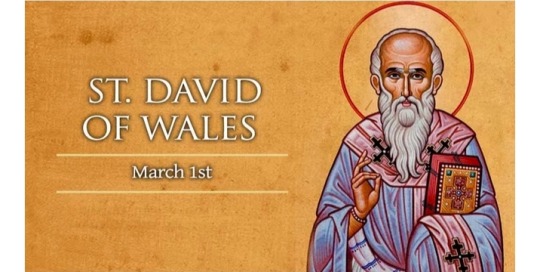
Among Welsh Catholics, as well as those in England, March 1 is the liturgical celebration of Saint David of Wales.
St. David is the patron of the Welsh people, remembered as a missionary bishop and the founder of many monasteries during the sixth century.
David was a popular namesake for churches in Wales prior to the Anglican schism, and his feast day is still an important religious and civic observance.
Although Pope Benedict XVI did not visit Wales during his 2010 trip to the UK, he blessed a mosaic icon of its patron and delivered remarks praising St. David as “one of the great saints of the sixth century, that golden age of saints and missionaries in these isles, and...thus a founder of the Christian culture which lies at the root of modern Europe.”
In his comments, Pope Benedict XVI recalled the saint's dying words to his monastic brethren: “Be joyful, keep the faith, and do the little things.”
He urged that "St. David's message, in all its simplicity and richness, continue to resound in Wales today, drawing the hearts of its people to renewed love for Christ and his Church.”
From a purely historical standpoint, little is known of David’s life, with the earliest biography dating from centuries after his time.
As with some other saints of sixth-century Wales, even the chronology of his life is not easy to ascertain.
David’s conception is said to have occurred as a result of rape – a detail that seems unlikely to have been invented by later biographers, though it cannot (like almost all of the traditions surrounding his life) be established with certainty.
His mother Saint Nonna or Nonnita has her traditional feast day on March 3.
David appears to have been the cousin of his contemporary Saint Teilo, another Welsh bishop and monk.
He is described as a pupil of the monastic educator Saint Paulinus, who was one of St. Teilo’s teachers as well.
There are doubts, however, about the story, which holds that David and Teilo traveled to Jerusalem and were ordained together as bishops.
It is clear that David served as the Bishop of Menevia, an important port city linking Wales and Ireland in his time.
His leading role in two local councils of the Church is also a matter of record.
Twelve monasteries have their founding ascribed to David, who developed a reputation for strict asceticism.
His monks modeled their lives on the earliest desert hermits – combining hard manual labor, silence, long hours of prayer, and a diet that completely excluded meat and alcohol.
The monks did not use animals to take care of their fields. They relied only on bread, vegetables, and water.
One tradition places his death in the year 601, but other writers believe he died in the 540s.
David may well have survived to an advanced age, but evidence is lacking for the claim (made by his 11th-century biographer) that he lived to the age of 147.
Pope Callistus II canonized St. David of Wales in 1120.
5 notes
·
View notes
Photo




“ Elder Tychon was an elder who lived an ascetic and solitary life on Mount Athos.
Papa-Tychon was born in Novaya Mikhalovka, Russia, in 1884, from pious parents, Pavel and Elena. When he was seventeen, they gave him their blessing to go on a pilgrimage to the monasteries of Russia for three years. “
He passed through a lot of monasteries until he found his way on Mt. Athos. When anyone asked him, ‘Do you live all alone in the desert?’ the elder would reply: ‘No, I live with the angels and archangels, with all the saints, with the Mother of God and with Christ’.
“ Once, a man attempted to rob him, even going so far as to tie a rope around his neck in order to force him to give up his money, of which of course he had none. When the police finally caught the thief, they tried to get Papa-Tychon to testify against him, but he replied, ‘But, my child, I forgave the thief with all my heart’. Although the police laughed this off, ‘In the end the police chief took pity and let him go back to his Cell from Hierissos because he was crying like a little child at the thought that he would be to blame for the thief being punished’. Whenever he would have a visitor, after praying with them in the chapel and visiting for a while, Papa-Tychon ‘would get up with great joy and say: ��Now, I have a treat for you”.
St. Paisios was his disciple and stayed with him until his last breath.
(x x x x x x x) Ꮚ˃ꈊºัᏊ
#hermit#orthodoxy#churchposting#pls i invite ppl who can read this to learn more abt him#it was a little bit hard to find info abt him waa#i added extra links who anyone interested
29 notes
·
View notes
Text
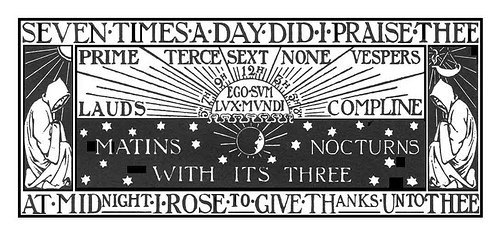
"The Opus Dei should be an experience of the presence of God, in which we realize God is present for us, at the same time that we are in God’s presence and living for him. This idea of being simultaneously present to each other–God to us and we to God–is the heart of our life of prayer."
~From In The Presence of God, Monastery of Christ in the Desert
#Liturgy of the Hours#Opus Dei#Christian#prayers#presence of God#God is present for us#We live for God#Monastery of Christ in the Desert#Abiquiu New Mexico
54 notes
·
View notes
Photo

Today we also celebrate our Venerable Father Alexander, Founder of the Unsleeping Monastery. Born in Asia and educated in Constantinople, he went into the army after completing his studies and became an officer. Reading the Holy Scriptures, he came upon the Saviour's words: 'If thou wilt be perfect, go and sell all thou hast, and give to the poor, and thou shalt have treasure in heaven; and come and follow Me' (Matt. 19:21). These words made such an impression on him that he sold and gave away all that he had, and went off to the desert. After long asceticism and striving for purification, he founded the community of the 'Wakeful Ones' (Acoemetae) with a special rule. According to this rule, the services in the church continued day and night in unbroken sequence. The brethren were divided into six groups, each having its appointed hours of day or night to go to church and take over the reading and singing from the previous group. He travelled a great deal over the East, bringing people to faith in Christ, disputing with heretics, working miracles by God's grace and growing old in the service of the Lord Jesus. He finished his earthly course in Constantinople in the year 430, where his relics revealed the miraculous power and glory with which God had glorified His holy servant. May he intercede for us always + Source: https://www.ancientfaith.com/podcasts/saintoftheday/our_holy_father_alexander_founder_of_the_monastery_of_the_unsleeping_o1 (at Constantinople - Κωνσταντινούπολη) https://www.instagram.com/p/Co-dc34rWBX/?igshid=NGJjMDIxMWI=
24 notes
·
View notes
Text

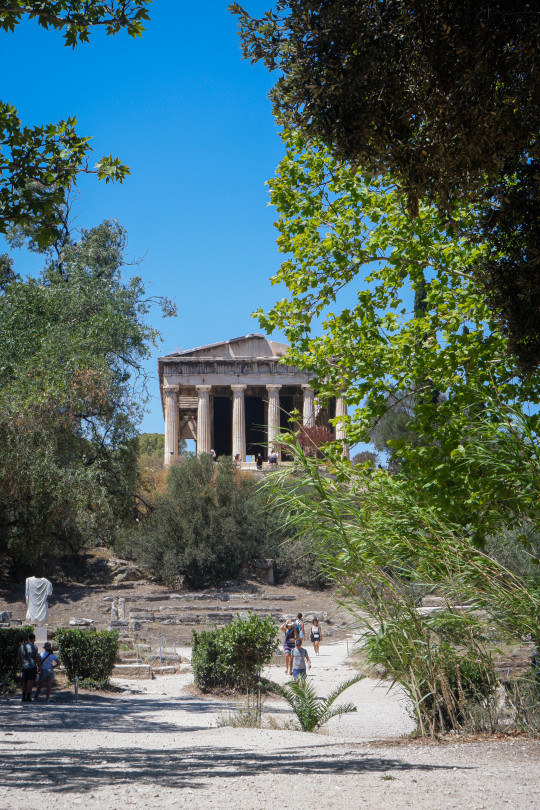
Greek Islands, Cyprus, Jordan & France - Full Itinerary
This summer I made one of my life goals come true and travelled for 3 weeks to 5 countries (the 4 I was meant to visit originally + an accidental stopover in Austria) including Greek mainland and island hopping as well as visiting one of the 7 Wonders of the World, Petra in Jordan.


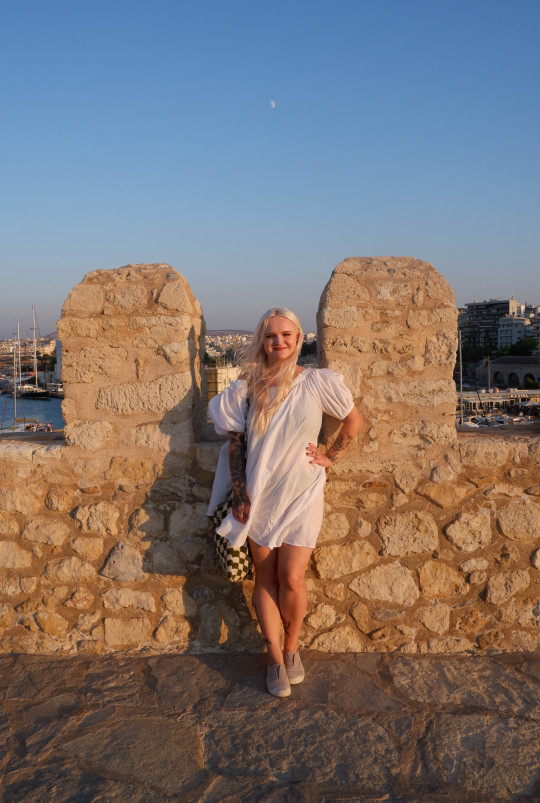
ATHENS - GREECE
Official gov tourism website https://www.visitgreece.gr/mainland/attica/athens/
Day 1
Take a 40 min bus from the airport
Temple of Olympian Zeus - Acropolis & Slopes Pass
Hadrian’s Arch - FREE
Theatre of Dionysus - Pass
Ruins of Asklepieion and Stoa of Eumenes - Pass
Odeon of Herodes Atticus - Pass
Acropolis of Athens - Pass
Erechtheoin - Pass
Temple of Athene Nike - Pass
Parthenon - Pass
Acropolis Museum - €15
Coming down the hill Areios Lagos (ancient law court) - FREE
Ancient Agora of Athens - Pass
Temple of Hephaestus (at the ancient agora) - Pass
Monastiraki Square - FREE
Hadrian’s Library - Pass
Day 2
Plaka - FREE
Zappeion Garden - FREE
Ethnikos Kipos (Athens national garden) - FREE
Kalamaki Beach - FREE
Day 3
The Prison of Socrates - FREE
Church of Saint Demetrios Loumbardiaris - FREE
Pnyx - FREE
Philopappou Hill - FREE
Flight from Athens to Santorini
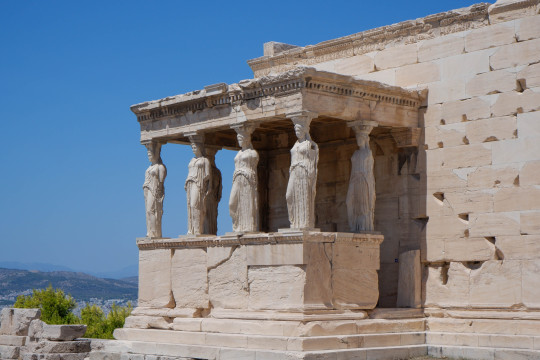
SANTORINI - GREECE
Day 1
Thera (Fira) day out - 30 min bus (€2)
Three Bells of Fira - FREE
Black sand beach - FREE
Day 2
Day trip to Oia
Day 3
Ancient Fira - £5
Ferry to Heraklion

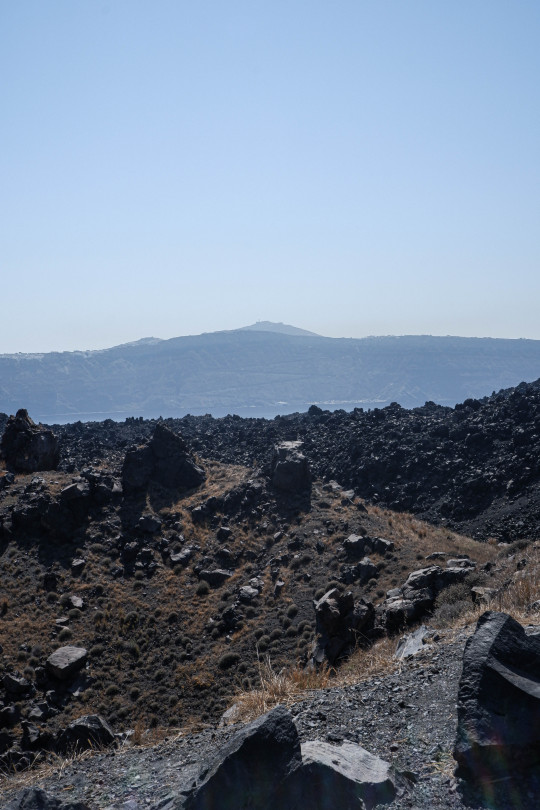
HERAKLION - GREECE
Day 1
Beach day - FREE
Day 2
Venetian port Heraklion - FREE
Old Town - FREE
Day 3
Knossos Palace - £15
Heraklion Archaeological Museum - Included in the ticket
Day 4
Take the bus to Chania, 2 hours 30 min https://www.allincrete.com/buses-timetables/ around £15
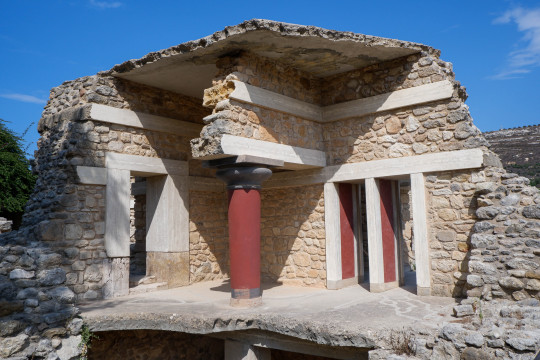
CHANIA - GREECE
Day 1
Old Venetian Port of Chania - FREE
Lighthouse of Chania - FREE
Boat Trip - many depart daily from the port for £25
Day 2
Chania International Airport flight to Paphos
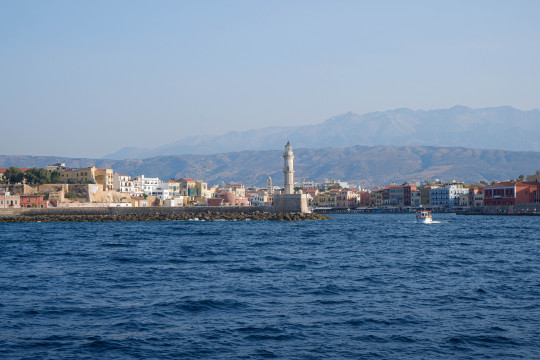
PAPHOS - CYPRUS
Day 1
Take a 25 min taxi to the hotel
Explore Paphos Old Town - FREE
Day 2
- Venus Beach - FREE
Day 3
Archaeological Site of the Tombs of the Kings - £2
Day 4
Archaeological Site of Nea Paphos - £4
Paphos Castle - FREE
Forty Columns Fortress - PAID
Paphos Mosaics - PAID
House of Dionysus - PAID
Villa of Theseus - PAID
House of Orpheus - PAID
Agora - PAID
Lighthouse - FREE
Day 5
Flight to Amman Queen Alia International Airport
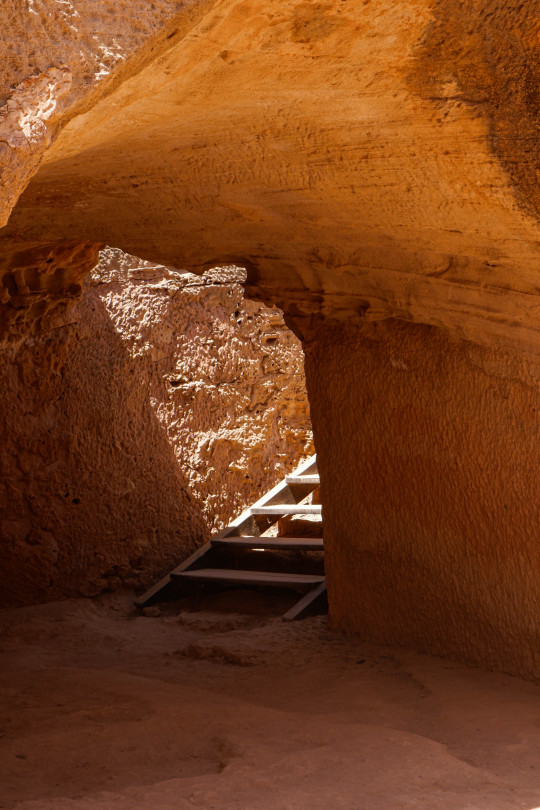
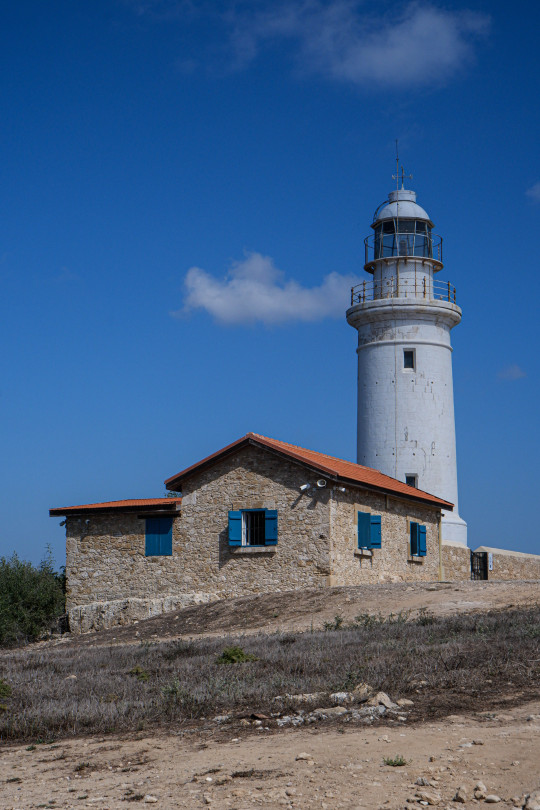
AMMAN - JORDAN
Day 1
Take a bus from the airport (departs every 30 min)
Roman Theatre - JORDAN PASS
Folklore Museum - JORDAN PASS
Amman Citadel: Open Cistern, Palace - JORDAN PASS
King Abdullah I Mosque - FREE
Rainbow Street - FREE
JORDAN PASS (includes visa) https://jordanpass.jo/Contents/Prices.aspx
Day 2
Take a bus from Amman to Petra 6:30 am takes 3 hours arrival 9:30 am https://www.jett.com.jo/en

PETRA - JORDAN
Day 2
Petra Tourist Office - FREE
Petra Museum - included in the JORDAN PASS
Siq (the Treasury) trail, then Jabal Haroun trail, then the climb up 900 steps Ad-Dier Monastery Hike - JORDAN PASS
Take a 40 JOD taxi to Wadi Rum Visitor Centre
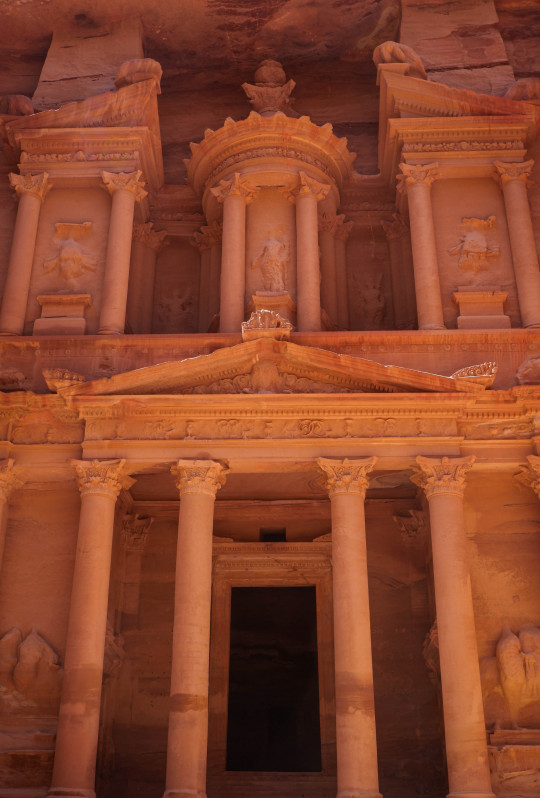
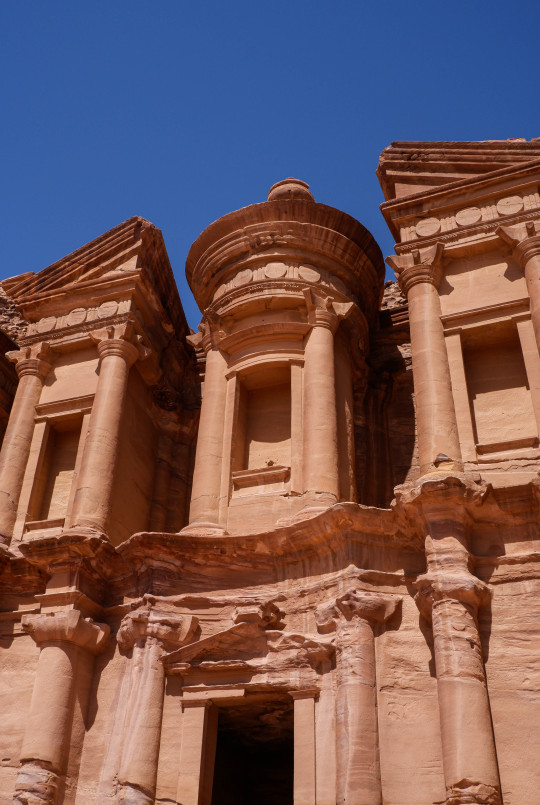
WADI RUM - JORDAN
Day 2 Continued
Pick up from Wadi Rum Visitor Centre for 5 JOD organised by the camp (let them know arrival time one day prior to the stay)
Check-in at Desert Magic Camp & Resort Ad Disah Road 1, 77110 Wadi Rum, Jordan
Traditional dinner - 13 JOD
Day 3
Jeep tour of the desert (regular 4 hours) - 22 JOD
5 JOD jeep ride back to Wadi Rum Visitor Centre
Take a bus back to Amman

AMMAN - JORDAN
Day 3 Continued
Dinner at Hashem Restaurant
Day 4
Swim in the Dead Sea - Amman Beach - Dead Sea - FREE or ask your hotel for a private driver around 80 JOD for two people with access to a private beach at one of the resorts
The Baptism Site of Jesus Christ https://www.baptismsite.com/operating-hours-a-entrance-fees/ - 12 JOD
Flight to Paphos then flight to France Marseille Provence Airport

MARSEILLE - FRANCE
Day 1
Chateau d’If via boat - €6 transport not included
Day 2
Palais Longchamp - FREE
Cathedral La Major - FREE
Basilica of Notre-Dame of la Garde - FREE
Flight from Marseille Provence Airport back to the UK
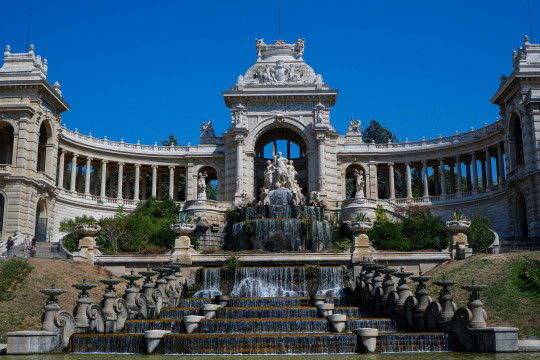
#travel#travel journal#travel diary#journal#travel plan#travel itinerary#travelphotography#photograpy#memories#traveling#travel photography
3 notes
·
View notes
Text
Today the Church remembers St. Anastasia the Patrician
Ora pro nobis.
Anastasia the Patrician was the daughter of an Egyptian nobleman and a lady-in-waiting in the court of Emperor Justinian in Constantinople. Justinian pursued her amorously, and she fled the court to take up a religious vocation in a convent in Alexandria, Egypt. When Justinian's consort, Theodora, died, Anastasia had to flee again, as he was seeking her. She went out into the Egyptian desert where she was allowed to dress as a monk and to remain in place. For twenty-eight years Anastasia remained in solitude in the desert, in constant prayer.
She arrived at a place called Pempton, near Alexandria, where she founded a monastery which would later be named after her. She lived with monastic discipline and wove cloth to support herself.
Following the death of Theodora in 548 AD, Justinian attempted to get Anastasia to return to Constantinople, to no avail. Instead, Anastasia left for Scetis, looking for help from Abba Daniel, hegumen of the monastery at that time. To safeguard Anastasia, he let her move into a laura, or monastery cell, 18 miles from Scetis in the desert, and dress as a (male) monk to hide her from the emperor and take up the life of a hermit at a time when this was only permitted of men. He visited her every week and ensured that one of his disciples supplied her with jugs of water. Anastasia dwelt in seclusion for twenty-eight years.
In 576 AD, aware of her approaching death, she wrote several words for Abba Daniel on a piece of broken pottery and placed it at the entrance to the cave. The disciple found an ostracon with the words "Bring the spades and come here." When Daniel heard this, he knew Anastasia was near death. He went to visit her with his disciple and to give her communion and hear her last words. Daniel revealed the full details of her story to his disciple after her death.
Her story survives in one recension of the Copto-Arabic Synaxarion and by a tale of Daniel of Scetis. Her feast day is 10 March in the Eastern Orthodox, Latin and Eastern Catholic Churches, and on 26 Tobi in the calendar of the Coptic Church, the date of her death given in the Ethiopic Life of Daniel of Scetis.
O God, whose blessed Son became poor that we through his poverty might be rich: Deliver us from an inordinate love of this world, that we, inspired by the devotion of your servant Anastasia, may serve you with singleness of heart, and attain to the riches of the age to come; through Jesus Christ our Lord, who lives and reigns with you, in the unity of the Holy Spirit, one God, now and forever. Amen.

5 notes
·
View notes
Text

St. Theodosius the Great, Feast Jan 11th
This Saint had Cappadocia as his homeland. He lived during the years of Leo of Thrace, who reigned from 457 to 474. The Saint established in the Holy Land a great communal monastery, wherein he was the shepherd of many monks. While Saint Sabbas was the head of the hermits of Palestine, Saint Theodosius was governor of those living the cenobitic life, for which reason he is called the Cenobiarch. Together with Saint Sabbas, towards whom he cherished a deep brotherly love in Christ, he defended the whole land of Palestine from the heresy of the Monophysites, which was championed by the Emperor Anastasius and might very well have triumphed in the Holy Land without the opposition of these two great monastic fathers and their zealous defense of the Holy Council of Chalcedon. Having lived for 103 years, he reposed in peace.
Apolytikion
Plagal Fourth Mode
With the rivers of your tears, you have made the barren desert fertile. Through sighs of sorrow from deep within you, your labors have borne fruit a hundred-fold. By your miracles you have become a light, shining upon the world. O Theodosios, our Holy Father, pray to Christ our God, to save our souls.
Kontakion
Plagal Fourth Mode
As being planted in the courts of Christ thy Lord and God, with holy virtues thou delightfully didst blossom forth and didst multiply thy children amid the desert, who were watered with the showers of thy fervent tears, O chief shepherd of the godly sheepfold of our God. Hence we cry to thee: Rejoice, O Father Theodosius.
2 notes
·
View notes
Text
Himachal Pradesh in Winter: Top Snowy Escapes for 2025
Himachal Pradesh, often referred to as the "Land of Snowy Peaks," transforms into a winter wonderland as the temperature drops. With its snow-capped mountains, serene landscapes, and cozy hill stations, it’s the perfect destination for those seeking a magical winter experience. Whether you’re an adventure enthusiast, a nature lover, or someone looking for a tranquil retreat, Himachal Pradesh has something for everyone. Here are the top snowy escapes to explore in Himachal Pradesh during the winter of 2025, brought to you by TourMyHolidays.

1. Shimla – The Queen of Hills
Shimla, the capital of Himachal Pradesh, is a popular winter destination that captivates visitors with its colonial charm and snow-covered landscapes. The Mall Road, Ridge, and Jakhoo Temple become even more enchanting under a blanket of snow.
Top Attractions:
Ice skating at Asia’s only natural ice skating rink.
Exploring Kufri for snow activities like skiing and sledging.
Visiting Christ Church for its Gothic architecture and serene ambiance.
TourMyHolidays Tip: Book a heritage stay for a unique and cozy experience in Shimla.

2. Manali – Adventure and Serenity
Manali, nestled in the Kullu Valley, is a paradise for adventure seekers and honeymooners alike. Its breathtaking vistas and snow-laden surroundings make it one of the most sought-after destinations during winter.
Top Attractions:
Solang Valley for skiing, snowboarding, and paragliding.
Rohtang Pass for its surreal snowy landscapes (subject to accessibility).
Vashisht Hot Springs to warm up after a day in the snow.
TourMyHolidays Tip: Don’t miss a romantic walk through Old Manali’s snow-covered trails.

3. Dalhousie – A Colonial Winter Retreat
Known for its old-world charm, Dalhousie offers a serene escape with stunning views of snow-draped pine forests and Victorian-era architecture. It’s a perfect destination for those seeking peace and quiet.
Top Attractions:
Khajjiar, often called the "Mini Switzerland of India," for its snowy meadows.
Dainkund Peak for panoramic views of the Himalayas.
Chamera Lake for a serene boat ride amidst snowy surroundings.
TourMyHolidays Tip: Visit local bakeries for warm treats and hot beverages.

4. Spiti Valley – The White Desert
For those looking for an offbeat adventure, Spiti Valley offers an otherworldly experience. Known as the "Middle Land" between India and Tibet, this high-altitude destination turns into a pristine white desert during winter.
Top Attractions:
The ancient Key Monastery covered in snow.
Trekking on frozen rivers for an adrenaline rush.
Visiting the villages of Kaza and Tabo for their unique culture and hospitality.
TourMyHolidays Tip: Ensure you’re well-prepared for extreme cold and altitude changes.

5. Narkanda – A Hidden Gem for Snow Lovers
Located near Shimla, Narkanda is a hidden gem that offers untouched beauty and a serene environment. It’s a lesser-known destination perfect for those who want to avoid crowded tourist spots.
Top Attractions:
Skiing at Hatu Peak, one of the best spots for beginners and professionals.
Tannu Jubbar Lake for its tranquil and picturesque setting.
Apple orchards covered in snow, providing postcard-worthy views.
TourMyHolidays Tip: Stay in a homestay to enjoy local Himachali cuisine and warm hospitality.

Why Visit Himachal Pradesh in Winter?
Winter in Himachal Pradesh is not just about snow; it’s about experiencing the warmth of its culture, the thrill of adventure, and the tranquility of its landscapes. From exciting snow sports to cozy evenings by the fireplace, the state offers a complete package for winter travelers.
Plan Your Himachal Winter Escape with TourMyHolidays
At TourMyHolidays, we specialize in crafting unforgettable travel experiences. When you choose us for your Himachal Pradesh trip, you get:
Customizable Packages: Tailored to fit your preferences and budget.
Expert Guidance: Local experts to help you explore hidden gems.
24/7 Support: Assistance throughout your journey for a hassle-free experience.
Make your winter of 2025 unforgettable by exploring the snowy wonderland of Himachal Pradesh. Contact TourMyHolidays today to book your dream vacation!
0 notes